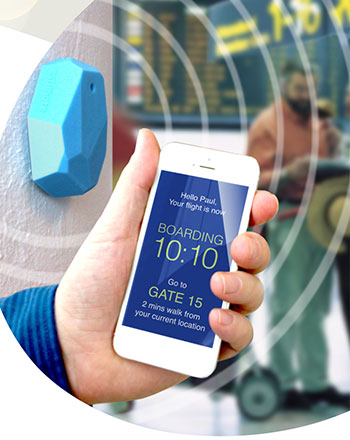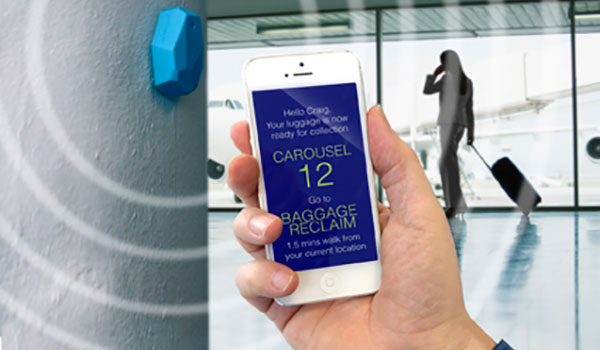
In response to the increased interest in so-called ‘beacon’ technology within the travel and transport sectors, SITA Lab is currently carrying out trials and has published its first insight paper on the subject, highlighting the pros, cons and possible next steps.
For those unfamiliar with the technology, beacon devices are an indoor proximity system available in various shapes and sizes. They transmit a signal using Bluetooth Low Energy (BLE) and when a BLE-enabled device, such as a smartphone, moves within range of the beacon’s signal it can trigger an action, such as displaying a contextually relevant message on the phone. So, in an airport environment, the beacon could trigger an app on your smartphone to send notifications or promotional coupons as you enter the departure lounge, for instance.
Last month, Virgin Atlantic announced that it is testing iBeacons alongside SITA – in addition to its trial of Google Glass – to inform passengers at London Heathrow of discounts in the vicinity and to provide automatic boarding updates.
However, while retail is seen as the driving force, the SITA paper – ‘Connecting to your passenger – are beacons the breakthrough?’ – identifies other potential uses:
- Passenger location – airlines in particular, with their apps stored on the passenger’s smartphone, can combine the app’s knowledge of the passenger with accurate knowledge of their location in the airport derived from detecting the nearest beacon. This can be useful for sending relevant information to the passenger and even locating them in the airport if they are late to the gate.
- Triggering mobile boarding passes – beacons can be placed at key passenger touch-points, such as check-in, bag drop, passport control and departure gates, and can be used to ‘pull’ mobile boarding passes onto the display of the passenger’s smartphone as they approach the checkpoint.
- Navigating the airport – beacons can provide a more precise and lower cost way for airport apps to guide passengers around the terminal to find their gate. These BLE-based beacons are said to be more accurate than alternative Wi-Fi and cellular signal-based alternatives.
- Baggage reclaim – A beacon in baggage reclaim could trigger a message to arriving passengers telling them which carousel their baggage will arrive on and how long they will need to wait.

While the benefits appear plentiful, SITA’s Chief Technology Officer, and the Head of SITA Lab, Jim Peters, urged the industry to adopt a cautious approach to deploying beacons, and explained that SITA Lab is working to build a common registry for the technology.
He said: “The relatively low cost of beacons makes them an attractive option for airports, but we need to be careful of adopting a gold rush approach to deploying them. It is clear from our initial research that beacons should be treated as a common use piece of infrastructure. Airports serve multiple airlines, and airlines travel to multiple airports. It is a very complex network – too complex for everyone to manage their own deployments. It will need careful management.
“Airports also need to carefully manage their radio space as beacons, which are radio-emitting devices, are deployed. They will need to have clear visibility of where, and how, the beacons are being set up to avoid disruption to each other’s signals and existing Wi-Fi infrastructure.”
He added: “The goal is that any airline will have a single point of contact to go to use any beacon deployed by airports around the world. We are already working with some early adopters but are looking for other airports, airlines and app developers who are interested in leveraging the potential of beacons in the air transport industry to join the project.”
The report concludes that if an industry registry is not embraced, the deployment of beacons risks becoming “piecemeal and proprietary, limiting the potential of the technology”.






